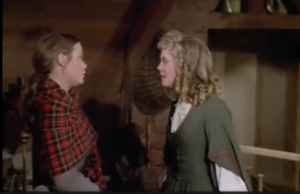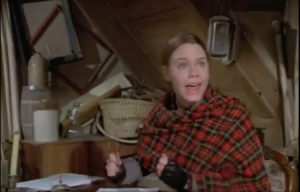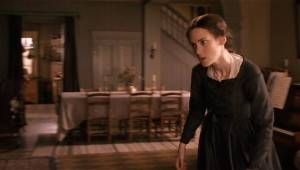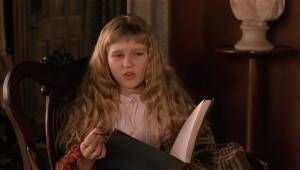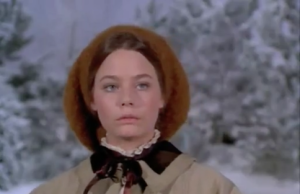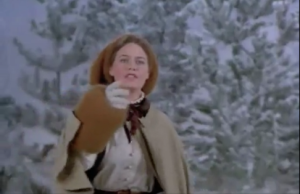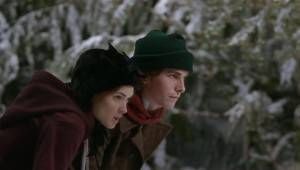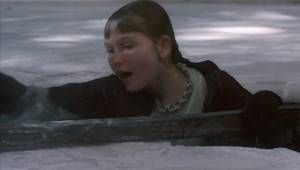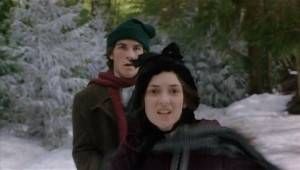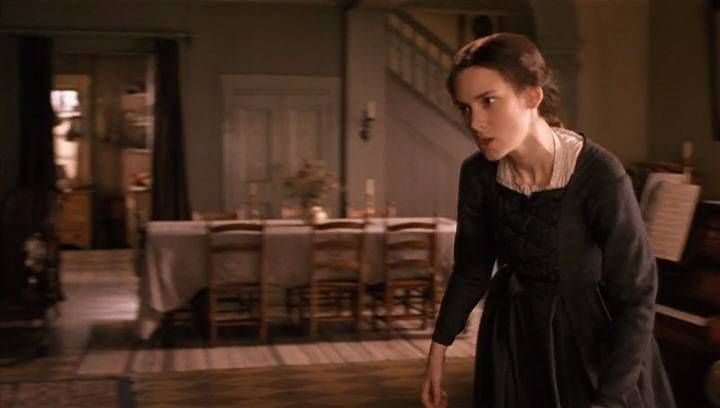
Anatomy of a Scene: Before and After the Book-Burning in Little Women
When I asked a friend who had never read or watched any version of Little Women what he knew about the story, he replied immediately, “Beth dies and Amy burns Jo’s book.” That certainly isn’t all Little Women is but it’s hard to argue with this distillation. Beth’s death is the ultimate tear-jerker moment, possibly even the first tear-jerker moment those who came to the novel early enough ever read. The second is arguably one of the most controversial events in the entire book, inspiring heated debate over who is the most wrong in this scenario, dividing Jo fans from Amy fans and big sisters from little ones.
So when I decided to compare a single scene across adaptations of Little Women I knew I had to pick this one – or more specifically, what happens before Jo’s book is burned and especially what happens after, often overlooked in so many of the discussions that centre on this scene. This chapter represents a critical moment in Jo’s development; it’s also the peak of the tension between Jo and Amy, the two most interesting March sisters and the two who are most frequently figured as opposites despite their similarities.
The problem was that while there are three major film adaptations of Little Women spanning sixty years, only one of them – Gillian Armstrong’s smart, vivid, gorgeous 1994 adaptation – includes the iconic manuscript burning scene. In order to find something to which to compare Armstrong’s film, I needed to go a little further afield in my search for adaptations.
This led me to a 1978 television miniseries directed by David Lowell Rich, an adaptation of Little Women that is little-remembered and little-loved – frankly, for good reason. The direction is flat and zaps all the novel’s vitality; the performances are stilted and there’s an utter lack of chemistry between the March sisters; and despite having four sixty-minute episodes in which to tell the story, the timeline is bizarrely compressed and scrambled. The aesthetics feel anachronistic and dated in a way that, say, George Cukor’s 1933 film adaptation don’t: this Little Women looks less like 19th century New England and more like a very special Civil War re-enactment episode of the Brady Bunch. Everyone is a blonde, blue-eyed California girl, and even the wallpaper is pastel.
But as different as this adaptation and Armstrong’s are in terms of overall quality, Rich’s version captures the import and spirit of Alcott’s scene in a way Armstrong’s doesn’t, putting me in the bizarre position of objecting to this scene in adaptation I otherwise adore, and if not outright liking, then at least grudgingly preferring this scene in an adaption I find generally unpalatable.
**********
A recap of the first scene as it happens in the novel: Amy discovers that Jo, Meg, Laurie and John Brooke have tickets to the theatre and begs to be allowed to come along. At first Meg reminds Amy that she is recovering from a cold and Marmee said she should be resting, but ultimately Amy’s pleading persuades Meg and she asks Jo if they couldn’t just bring her along. Jo, who doesn’t want to spend her evening looking after a “fidgety child,” angrily refuses. If Amy goes, Jo threatens, she won’t, which would upset Laurie who purchased the tickets in the first place. When Amy counters that she is willing to buy her own ticket, Jo still says no because Amy wouldn’t be able to get a ticket in the same reserved seats as the rest of them, meaning someone would have to break up the group to sit with Amy. Amy escalates into a full-on tantrum and her last, ominous words to her sister as she leaves are “You’ll be sorry, Jo March!”
Jo is a little bit sorry throughout the play; she cannot help thinking of Amy and regretting how cross she was with her. The next day Jo discovers how sorry Amy decided to make: she burnt Jo’s long-cherished manuscript, the work of years, in revenge for the perceived slight against her. Jo screams at Amy, shaking her until her teeth rattle, and vows never to forgive her. Meg reuses to console Amy and even Marmee is gravely disappointed in her.
Rich’s version of the “before” the manuscript version keeps the basic points but alters the context for both Jo’s and Amy’s behaviour, and plays fast-and-loose with the timeline of events. Because the latter happens with some regularity throughout this adaptation, it’s hard to be sure what the motivation for this change is, but certainly its effect is to make Amy more sympathetic. In this version, Amy is struck across the palm at school on the same day as Jo and Meg are going to the play (this is also the day before Mr. Lawrence gives Beth the piano). After Marmee promises Amy she doesn’t have to go back to school, Amy runs upstairs to tell Jo that they can transform Jo’s writing garret into a shared “artist’s quarters.”
Jo doesn’t wait to hear about what has happened to Amy, she just snaps “You’ll do no such thing! This is my garret!” Hearing Meg ask Jo what she’s going to wear to the play, Amy decides she wants to come along. Jo was in the middle of writing when Amy appears and irritated that her sister has interrupted her story and breached the sanctuary of her garret: “You weren’t invited!” “But I’ve had an awful day,” Amy cries when Jo first refuses her.
Gone in this version is Amy’s cold or the fact that Laurie purchased the tickets or the issue of the group seating. Here Jo is angry because Amy wasn’t invited, just as she wasn’t invited to interrupt Jo’s writing or share her garret, and Amy is in need of comfort and cheering up after being hit and humiliated at school. Although the context for both characters’ actions has changed on balance it’s clearly Jo who comes off as meaner than in Alcott’s book and Amy who becomes more sympathetic.
Armstrong’s adaptation of the events prior to the manuscript burning is, overall, quite faithful to the text: much of the dialogue is adapted directly from the novel and Winona Ryder and Kirsten Dunst are pitch-perfect as the stormy Jo and petulant Amy. Armstrong does make one small but significant change by giving Jo an additional reason for refusing Amy. In this film, after Amy is pulled out of school Jo is assigned the role of her tutor. When Amy asks to come along to the play, Jo is already frustrated with Amy for “appallingly” neglecting her schoolwork and insists she stay home to practice her grammar and sums.
Adding this to the scene shifts Jo’s motivations slightly. Yes, she is angry and yes, she doesn’t want Amy to tag along and ruin her fun, but this version of Jo, like Meg, also has a reason for refusing Amy that is for Amy’s own good. Under Alcott, Jo’s refusal is about what’s best for Jo; under Armstrong, it’s at least partially about what’s best for Amy.
In Alcott’s book Amy is desperate to earn Jo’s forgiveness and alternates between heartbreak and indignation when Jo understandably refuses to grant it. When she hears Jo and Laurie head down to the frozen lake to go skating, she takes Meg’s advice and decides to follow them and try to apologize to Jo again when she is in a better mood. Only Jo notices her tagging along; Laurie, oblivious to Amy’s presence, warns Jo about a dangerously thin patch of ice in the distance. Jo considers warning the trailing Amy, but ultimately decides to “let her take care of herself.” Amy promptly falls through the ice. Jo, terrified, freezes and it is Laurie who pulls Amy out of the icy water. Back at the March house, Jo is distraught and holds herself responsible for what happened. She confesses to Marmee, “Laurie did it all; I only let her go. Mother, if she should die, it would be all my fault.” Later Jo remonstrates herself for succumbing to her temper, wondering “How could I be so wicked?”
Rich’s adaptation of these events sees Amy catches up with Jo and again ask for forgiveness. Jo, who has been just told by Laurie about the thin ice, just ignores Amy and skates away without warning her. After a moment, though, Jo turns back and yells to warn her sister a split-second before Amy goes crashing into the water (in dramatic, screaming slow-motion no less). When the two return home safely, Suzanne Clauser’s script includes Jo’s confession to Marmee almost verbatim: “Laurie did everything. All I did was to let her go without a word [emphasis mine]. If she died it’d be my fault.” This dialogue, combined with what we see on screen, suggest that in this version Jo originally intended to let Amy fend for herself but had a last minute change of heart.
On the one hand, this adaptation clearly understands the series of events leading up to and following the burning of Jo’s book as being about Jo’s temper and attempts to adapt it accordingly. Meg condemns Jo’s temper in the garret before the play, and after Amy burns the book and Jo swears never to forgive her, Marmee gives an abridged version of her speech from the book about the importance of keeping one’s temper and her own struggles with the same. On the other hand, it seems Rich and/or Clauser are not comfortable making either March sister quite as “wicked” as Alcott allows. In both cases the “guilty” party is partially exonerated: Amy’s destruction of Jo’s book is slightly more somewhat understandable in light of what she has just endured and Jo’s outright nastiness, and Jo does think the better of her hard-heartedness and carelessness toward Amy, just not quite in time.
When it comes to the events following the burning of Jo’s manuscript, Gillian Armstrong’s adaptation of Little Women diverges from the text much more drastically. Armstrong’s film, Amy still falls through the ice after tagging along after Laurie and Jo, but neither Jo nor Laurie were aware of the thin ice beforehand. This version of the scene doesn’t just have Jo think the better of her decision, it eliminates that moment of choice entirely. Here the guilt Jo feels is for not reacting to Amy’s fall swiftly enough; the pain she feels is the fear of losing someone she loves before forgiving her, not the fear of being complicit in that loss. It’s a radically different thing and, in an adaptation this good with such a strong focus on Jo’s character, it’s also a shame.
Armstrong’s film devotes a great deal of time and attention to Jo’s personal, political, and creative growth. More than any other Little Women director Armstrong includes scenes of Jo actually writing. Under her direction, Jo’s writing is work – a process and a practice, not a fait accompli. She emphasizes Jo as a modern and politically-aware woman by weaving Alcott’s own beliefs into Jo’s character, including a scene in which Jo debates Transcendental philosophy and female suffrage with a group of men and more than holds her own. Armstrong’s Jo is a rich, complex, and thoroughly modern character. In such a good adaptation that otherwise insists on representing the breath of this young woman’s personhood, the decision to alter the scene in which Amy falls through the ice seems like a misstep.
Making Jo significantly more sympathetic, as Armstrong does, is a much bigger diversion from the text than making both Amy and Jo a little more sympathetic, as Rich does because the burning of Jo’s manuscript and Amy’s fall through the ice both exist to further Jo’s growth, not Amy’s. Alcott always labels her lessons, and the chapter in which Amy burns the book and falls through the ice is titled “Jo Meets Apollyon,” a reference to the Biblical fiend or destroyer.
More specifically, the title is part of the sustained reference to Pilgrim’s Progress that underpins Little Women (one of the most radical things about Alcott is her insistence on putting the quotidian struggles of teenage girls in their moral, and spiritual development on the same footing as that of a grown man).
Reading the chapter title in the context of Pilgrim’s Progress and the “burdens” or flaws each March girl learns to bear it’s clear that the fiend Jo battles isn’t Amy, it’s her own temper. To erase this evidence of Jo’s temper or to gloss over the gravity of the choice it leads her to make (and, sincerely, it is grave; anyone who thinks a year-old willfully destroying her her older sister’s art is exponentially worse than a fifteen year-old being deliberately careless with her younger sister’s safety perhaps over-values creative output) is to do a disservice to her complexity and her growth. And for all her occasional preachiness, Alcott understood better than most the often hard, embarrassing, and grievous work of growing up. Growth happens at the pace of two steps forward, one step back – even for girls.
**********
Where both adaptations fail, to varying degrees, at adapting the before and after of the burning of Jo’s book, is in the way they view wrongness. The key to this moment is not apportioning or mitigating wrongness, but reconciling a moment wrongness as part of a larger, real whole. What Alcott offers readers is one of a precious few novels devoted to the heroism and complex interiority of average girls. Not girls who always have the best intentions but are simply clumsy or prone to mishaps, or girl who are understandably angry in the face of massive, systemic social injustice, but girls who sometimes don’t have good intentions and who are understandably angry in the face of small, everyday, personal injustices. Too often young women, both fictional and real, are expected to sacrifice real humanity for the sake of uncomplicated likeability. Thankfully, Alcott never asks for that.



